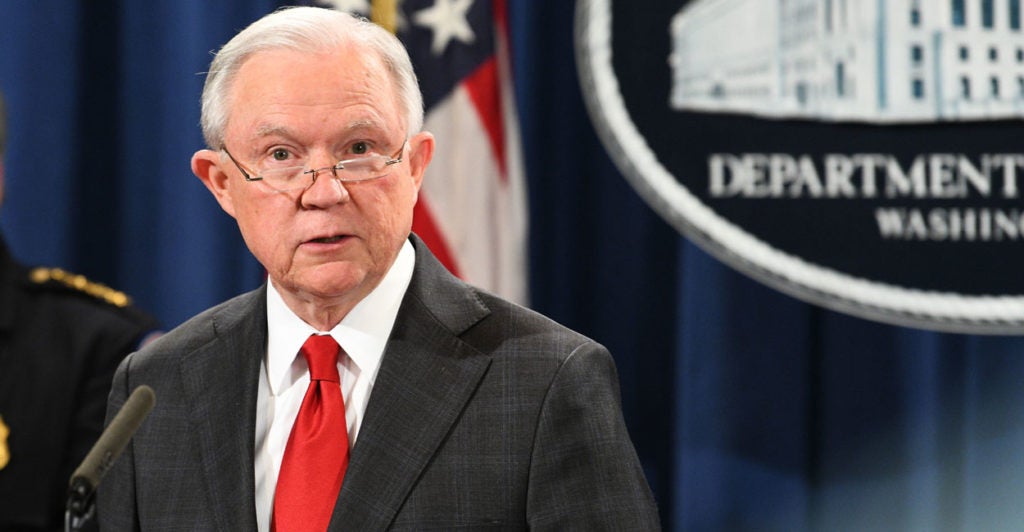In a routine pre-election action, Attorney General Jeff Sessions announced that the Justice Department’s Civil Rights Division will monitor polling sites in a total of 35 jurisdictions in 19 states.
Some left-leaning websites cast the move as a voter-suppression effort because the attorney general’s announcement talked about voter fraud.
In a press release Monday, Sessions said voter fraud “corrupts the integrity of the ballot.”
President Donald Trump later tweeted that fraudsters at the polls would face “maximum criminal penalties.”
Law Enforcement has been strongly notified to watch closely for any ILLEGAL VOTING which may take place in Tuesday’s Election (or Early Voting). Anyone caught will be subject to the Maximum Criminal Penalties allowed by law. Thank you!
— Donald J. Trump (@realDonaldTrump) November 5, 2018
The Obama administration’s Justice Department sent out nearly identical press releases about plans to monitor election sites ahead of the four national elections in 2010, 2012, 2014, and 2016.
Each press release from the Obama administration talked about prosecuting fraud in the context of enforcing elections laws and the right to vote.
This year, the Justice Department said it will send monitors to election sites in Alaska, Arizona, California, Florida, Georgia, Iowa, Kansas, Massachusetts, Nevada, New Jersey, New York, North Dakota, Oklahoma, Pennsylvania, Rhode Island, South Dakota, Texas, Utah, and Virginia.
The total of 19 states actually is scaled down from 2016, when the Justice Department monitored 67 jurisdictions in 28 states. In the preceding national election in 2014, the Justice Department monitored 28 jurisdictions in 18 states, slightly less than this year.
Nevertheless, The Daily Beast warned about a “last-ditch effort of voter suppression” in a story that combined the press release and Trump tweet.
The news and opinion website noted: “The DOJ plans to send officials to 35 jurisdictions in 19 states in an effort to monitor the vote on Tuesday—especially in places Republicans would ordinarily win, like North Dakota and Georgia, who’ve already experienced suppression efforts at the polls.”
The Washington Post appeared alarmed, reporting:
But the statement from Attorney General Jeff Sessions says the department plans to investigate voter fraud, something President Trump has claimed, without evidence, to be a huge problem since he was a candidate. … The statement doesn’t say what specific fraud-related issues the Justice Department personnel will be looking out for, and how much of their time will be spent investigating impediments to voting as opposed to claims of fraud.
The website AlterNet said: “Jeff Sessions is bending to Donald Trump’s false accusations of voter fraud.”
A database maintained by The Heritage Foundation contains 1,178 proven instances of voter fraud. They include 1,020 criminal convictions, 48 civil penalties, 81 diversion programs, 14 judicial findings, and 15 official findings.
“Voting rights are constitutional rights, and they’re part of what it means to be an American,” Sessions said in his statement Monday, adding:
The Department of Justice has been entrusted with an indispensable role in securing these rights for the people of this nation. This year we are using every lawful tool that we have, both civil and criminal, to protect the rights of millions of Americans to cast their vote unimpeded at one of more than 170,000 precincts across America.
Citizens of America control this country through their selection of their governmental officials at the ballot box. Likewise, fraud in the voting process will not be tolerated. Fraud also corrupts the integrity of the ballot.
Under the Voting Rights Act of 1965, the Justice Department’s Civil Rights Division is charged with enforcing federal voting rights laws.
“This is nothing unusual,” Han von Spakovsky, manager of the Election Law Reform Initiative at The Heritage Foundation and a former Justice Department lawyer, told The Daily Signal. “The Civil Rights Division has been doing this on a regular basis. They always send out press releases, usually announcing where the monitors will be.”
